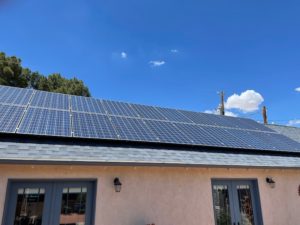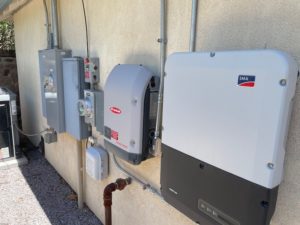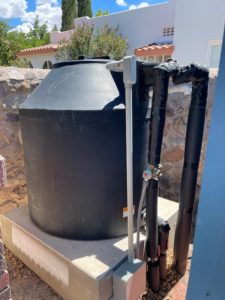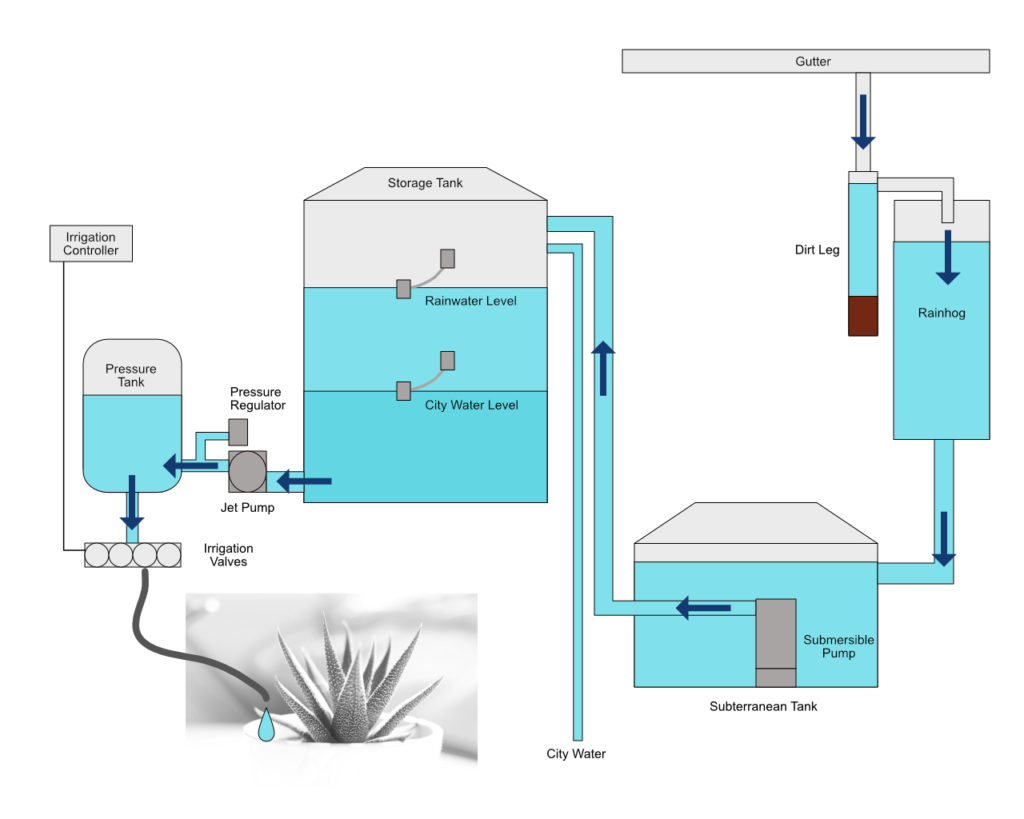
“How efficient can I get?” is a question I often ask myself. For almost a decade now my family has been working towards greater energy, water, and waste efficiency with a goal towards something like sustainability. It began with electric and hybrid cars and then, by 2013, we remodeled a house following a green sustainable model. All of the existing cabinetry, surfaces (as best could be done), and fixtures were non-destructively excised and passed to Habitat for Humanity. Nearly 10kW of photovoltaics were fixed to several roof surfaces. The only limitation was the HOA and CC&Rs of our California community that mandated a fairly uniform lawn requirement, thus limiting water conservation options. We could have battled for it, but the housing development itself spent north of $200K per year on gardening services, so it seemed an uphill fight to deviate from their idealized and fairly lush landscape plans.
So when remodeling our 1930s-era house in New Mexico, we went even further. In addition to 8kW of photovoltaics that push us easily into electricity producer over the course of a year, we added rainwater capture and reuse for watering a largely xeric collection of decorative landscaping plants plus some small food garden plots. The water system is not nearly as reliable as the PV systems, though even those have had some issues. I’ll get to pros and cons as I build out the basic designs further along. But I can certainly say that on balance the effort has been a net positive.
So, first, some design details.
Let’s start with the solar system. The 8kW of PVs are in two sections. 5kW is on a south facing roofline of our casita/office. We call it Chateau Derrière and it attaches to the previously unattached garage that dates to the 1930s and is comprised of stacked rock and a stick roof. All of the wood is in fine shape after 90 years, being New Mexico, and I only needed to spray a bit of expanding foam between some of the rock gaps to make it fairly impervious to dust. The other 3kW is on the garage itself and faces west. After around 5 years of continuous use, the system continues to perform well. Total generation to date is 45.65 MWh from the 5kW system and 20.31 MWh from the 3kW system, so a total of around 66 MWh. For comparison, depending on state, a family home might use around 10 MWh per year so our consumption and generation is just about dead on. We charge our daily driver, a Tesla Model S, starting at midnight almost every day. There is a reduction in off-peak electrical rates but Southern New Mexico, via service of El Paso Electric, does not yet offer a special electric vehicle charging rate. They are requesting permission to do so, but will also require a dedicated meter for the cars, so it probably is not cost effective to retrofit but might be a good idea for new construction.
Here’s an interesting puzzler for those of you contemplating photovoltaics. The following image shows a day in May when I decided to rinse off the south facing array:
The panels were very dusty, like everything most of the time in New Mexico, and had some bird droppings as well. I began rinsing at around 11:45 AM. But why the production spike? Skim forward after due thought.

So photovoltaics actually perform better when the panels are cool because the semiconductors are not as thermally energetic and electrons can move through higher potential differences. I sprayed the panels and cooled them, resulting in a spike. The enhanced peak generation afterwards is perhaps due to removing the dust layer interfering with transmission. There are some research and development efforts to cool PVs as a matter of course, but maintaining and managing the water systems is always higher maintenance than pure solid state systems like the PVs themselves.
Our only CONS with the PVs is with one of our string inverters that has popped errors and warnings around three times. This is a Fronius unit and the errors have been related to sudden spikes (twice) that may have been on the grid side of the inverter, as well as a recent DC Isolation Error during heavy rains here recently. The latter is under investigation but is a bit worrisome in terms of fire hazard. The other inverter is also a string inverter by Sunnyboy and has reported no issues, although both are annoyingly difficult to get on the internet and talking to their cloud-based monitoring systems. They both also periodically drop connections and data supplies for a day or two until I reset something, typically just kicking them off DHCP and letting them renegotiate a connection to the router. Our previous 10kW system in California used micro-inverters that communicated over the power lines themselves, which was even more flakey.
The water capture and reuse system is probably unnecessarily complex because there were too many cooks in the kitchen when planning and implementing the whole thing. We route our gutters into Rainwater H2OGs with a dirt leg at the entrance. These extra storage reservoirs then drain into an underground storage tank. The tank has a submersible pump that pumps into an aboveground tank. The motion of water between the two tanks is governed by float switches. Our installers originally set the city water float higher than the recovered water float and so we got no recovery at all for years! Lesson learned: always understand and test the system yourself. Contractors’ goals don’t always align with the outcome target and mistakes can be easily masked by a partially functional system.
The aboveground tank flows to a jet pump that pressurizes a pressure tank and we feed that through four valves controlled by a Rachio controller that does a decent job of applying weather intelligence to manage water utilization. This generally amounts to seasonal adjustments to the length of time zones run as well as rain skips and ground saturation skips. Here’s a diagram of the whole system:

The water distribution starts in the upper right with the flow from the gutters and proceeds to the left through the different components.
The water system definitely requires more maintenance than the PV system. I just replaced the pressure controller for the pump after five years ($20 from Tractor Supply Co.). The pressure membrane was leaking and not holding resulting in the pump running more than needed. I’ve also replaced the swing valve between the low and high pressure sides of the system almost every year. I tried soaking them in vinegar but it seems the mineral buildup etches or damages the brass over time. Or perhaps I need to soak for longer. In any case, the valve is a $10 item though I also bought a Pex kit to install threaded connectors around Year 3 to make replacement easier. The subterranean tank has gaps on the lid due to slight settling into the ground and obstruction by pavers at the top. The end result is some evidence of mosquito larvae that means I need to trim the pavers in the near future to get a better fit. In the short term, Summit Mosquito Dunks are helping out.
Altogether, the combined systems save thousands of dollars on electricity and water every year. We do have natural gas for heating in our HVAC system, cooktops, and one water heater as well, but the usage of those is relatively low except in deep winter. As part of the remodel, we did have insulation blown into our attic and stapled to the underside of our wood floors. While it helps, there is a clear winner in terms of heat/cool efficiency in the newer construction of our casita. Despite the main house having brick, ceramic blocks, and lath-and-plaster (from outside to in), the walls become very cold in the winter compared to stucco, sheathing, insulated gap, and drywall.
I’ve been trying to envision how these systems can potentially become more maintenance free. PVs with micro-inverters certainly seem an advance on the bulky string inverters and I regret not using them again in this application. Water harvesting is just more difficult, however, unless done at a reduced scale. A single Rainwater H2OG connected to a gutter and gravity feeding through a valve controller into a planter would be simple enough, but getting sufficient head pressure for wider distribution does require some kind of pumping and pressure regulating mechanisms. So it seems destined to remain a cottage industry of specific applications in the near term. Direct integration into a prefab housing system could simplify some of the components, though. Ultimately, a home owner would prefer to just hook up the irrigation valves to a water supply and have it all happen automatically. Much work is needed to get to that point, I’m afraid.

Edits